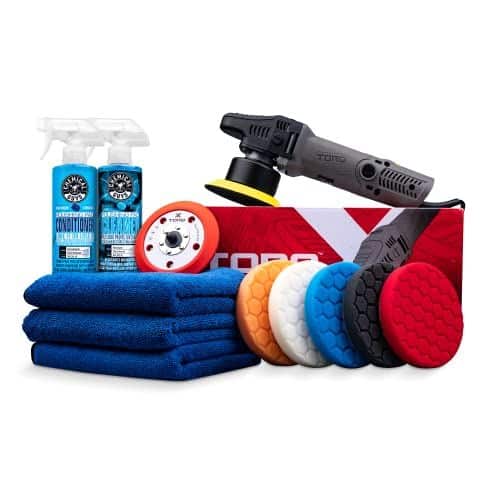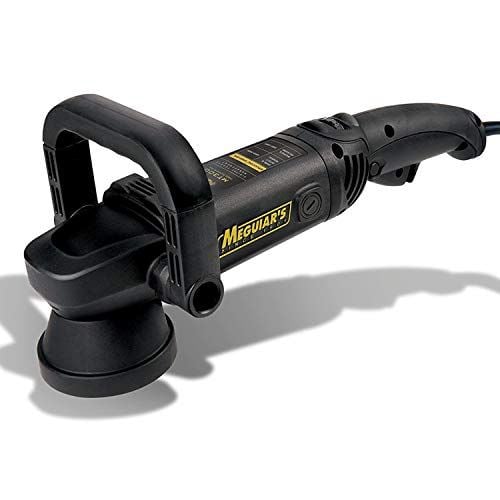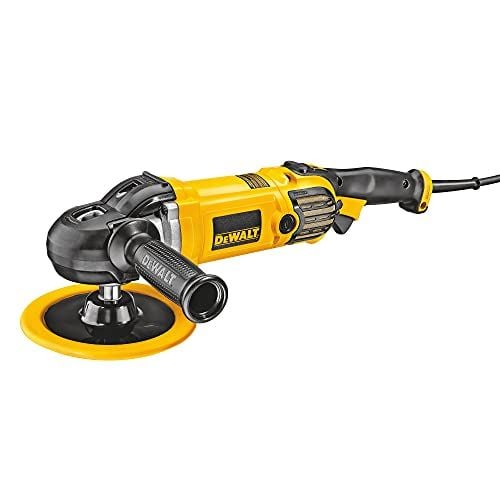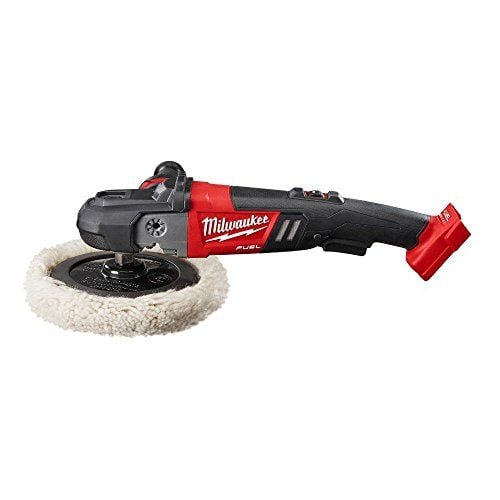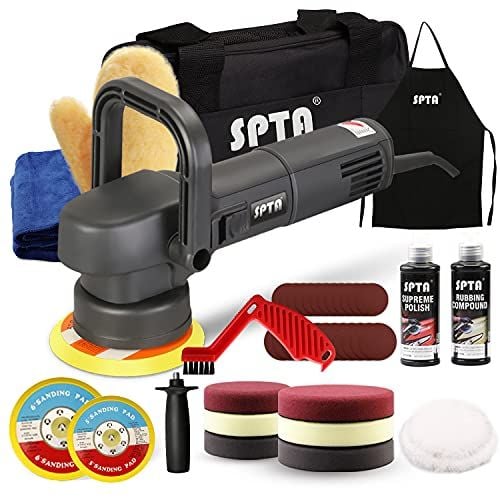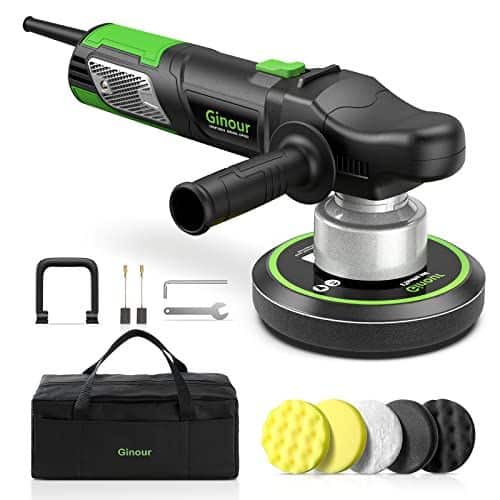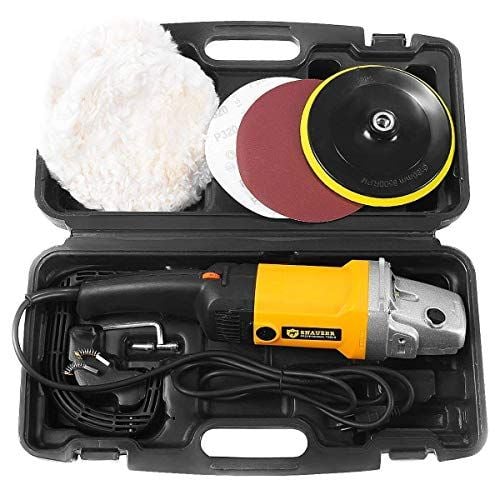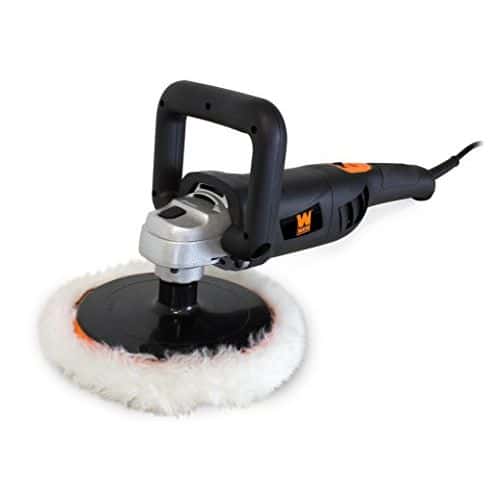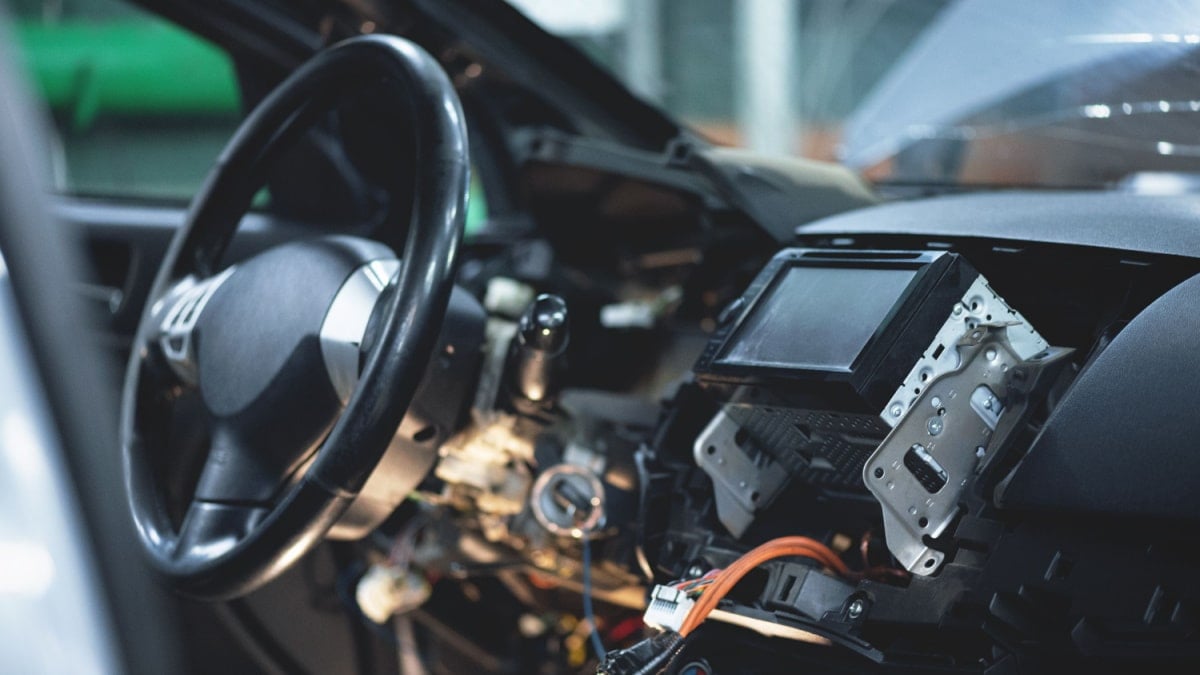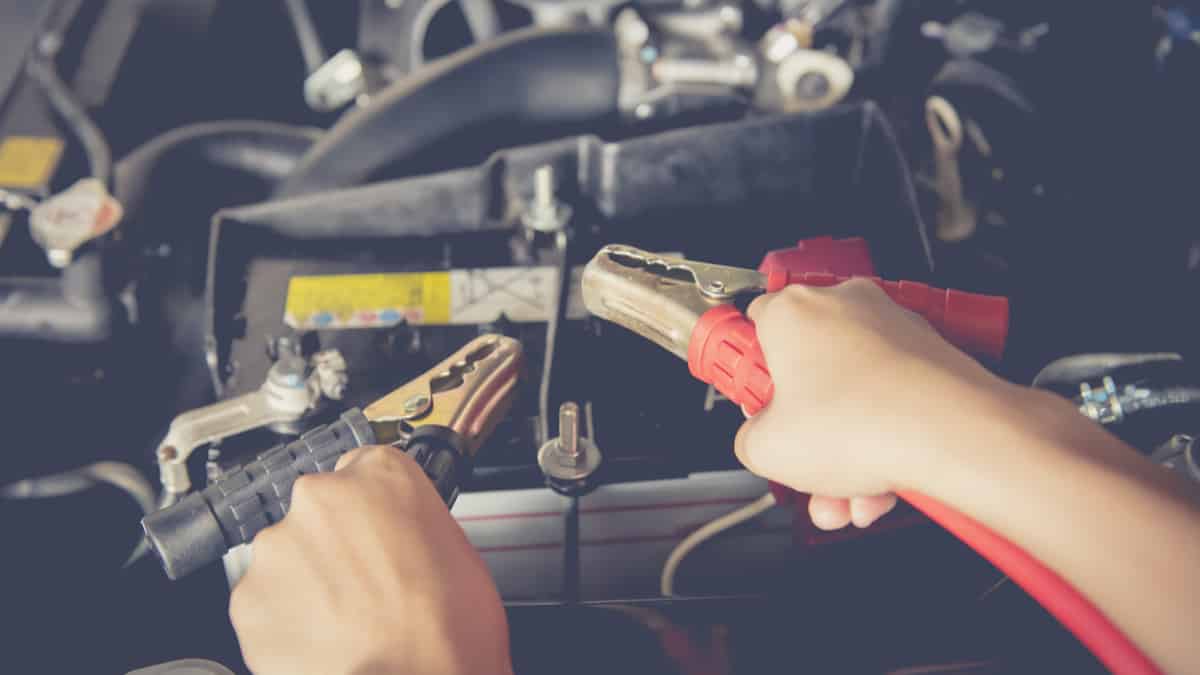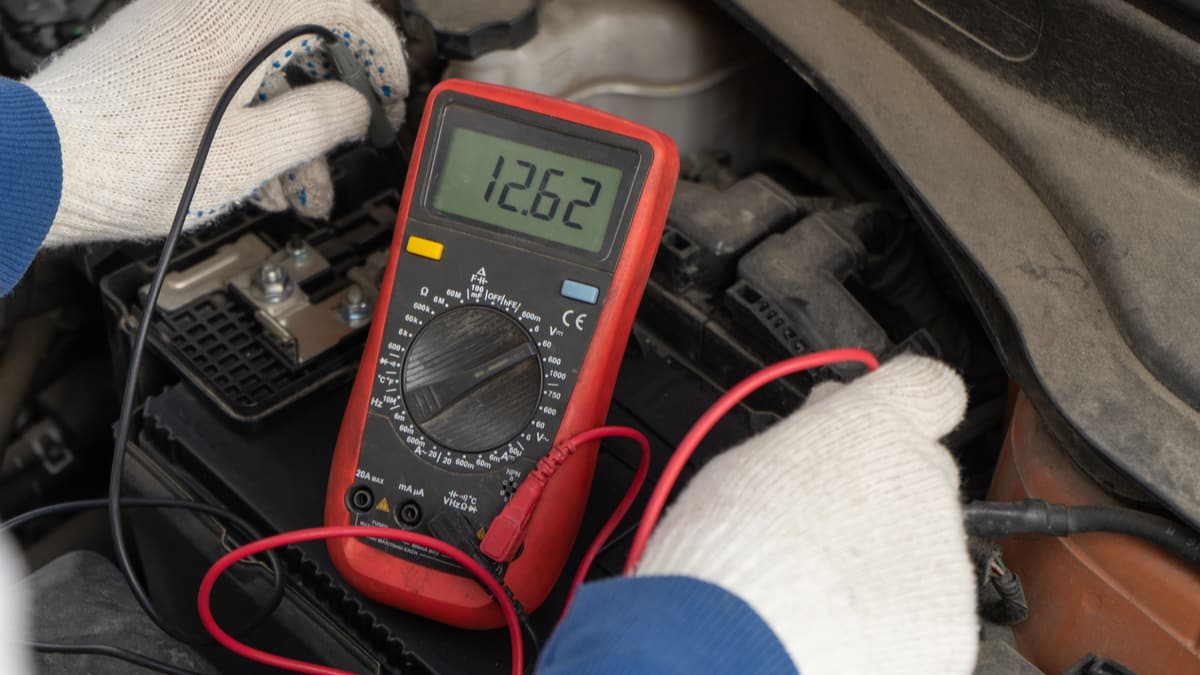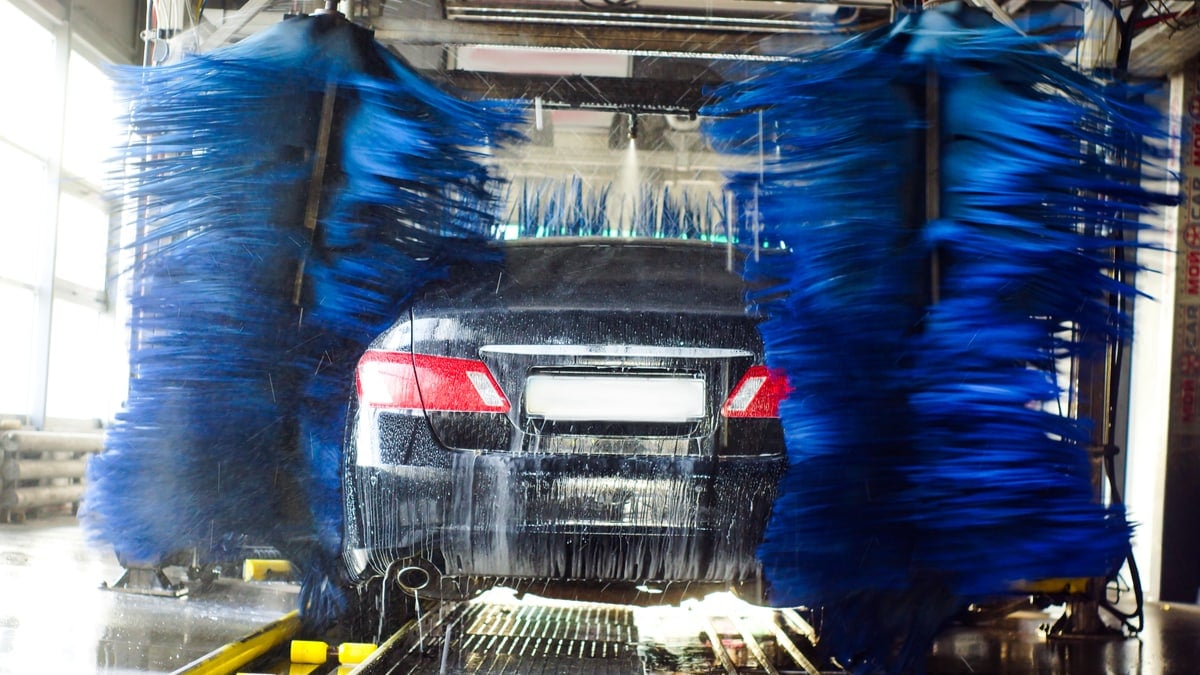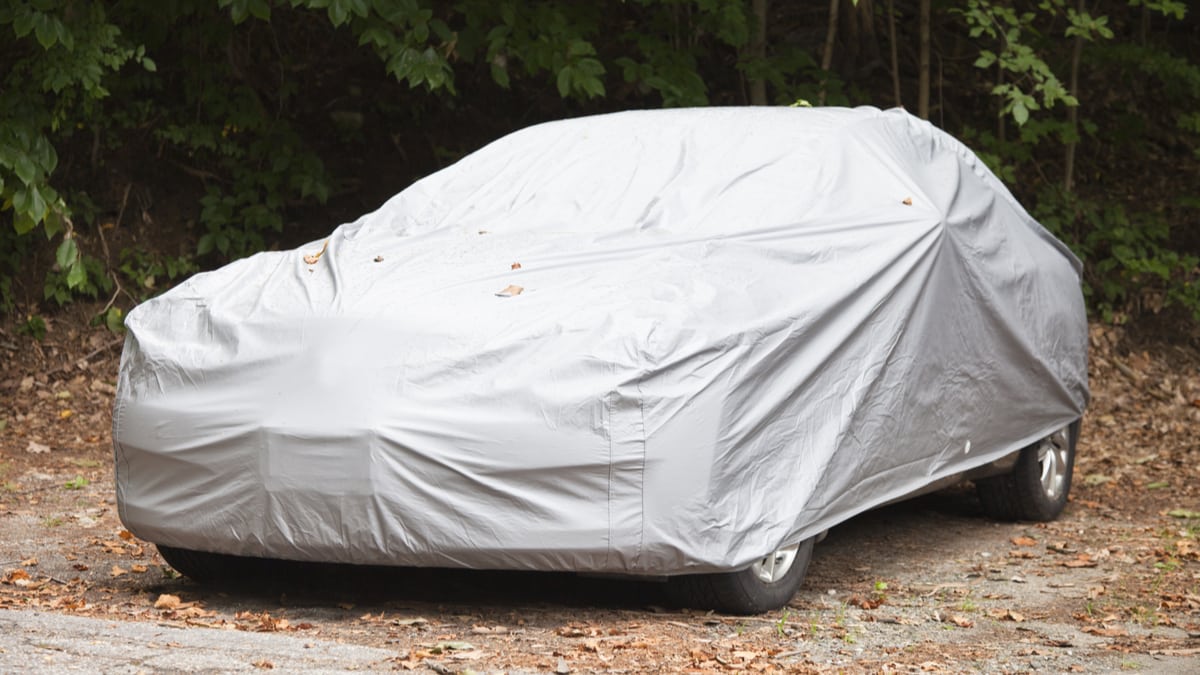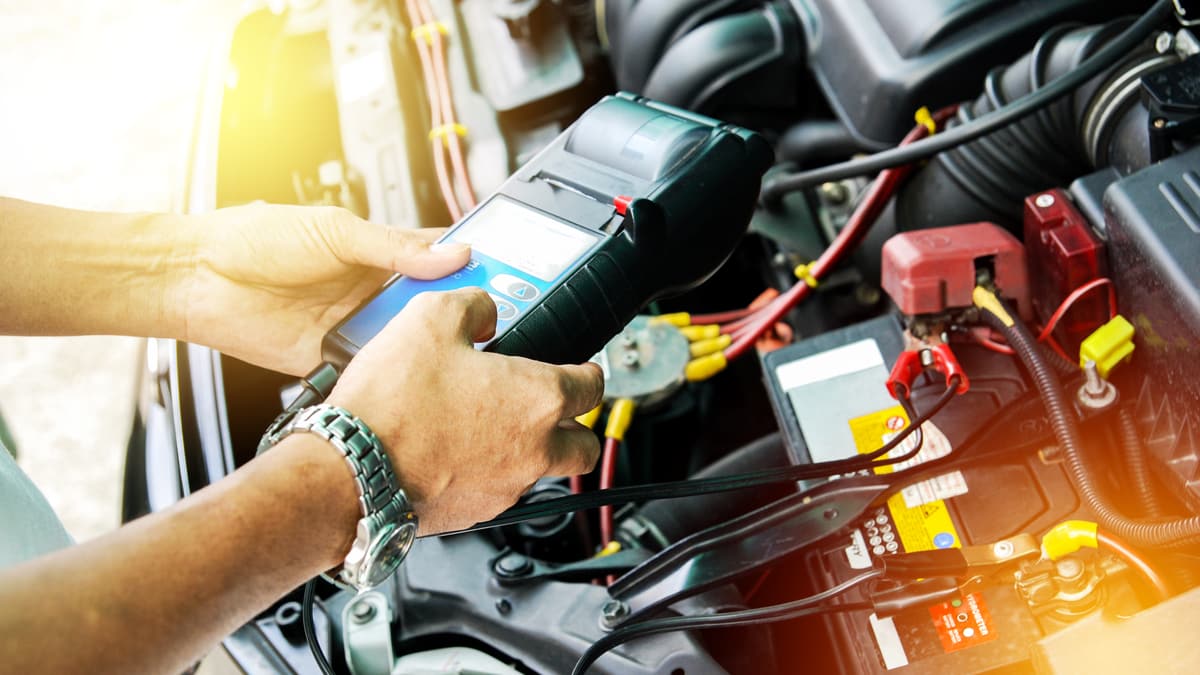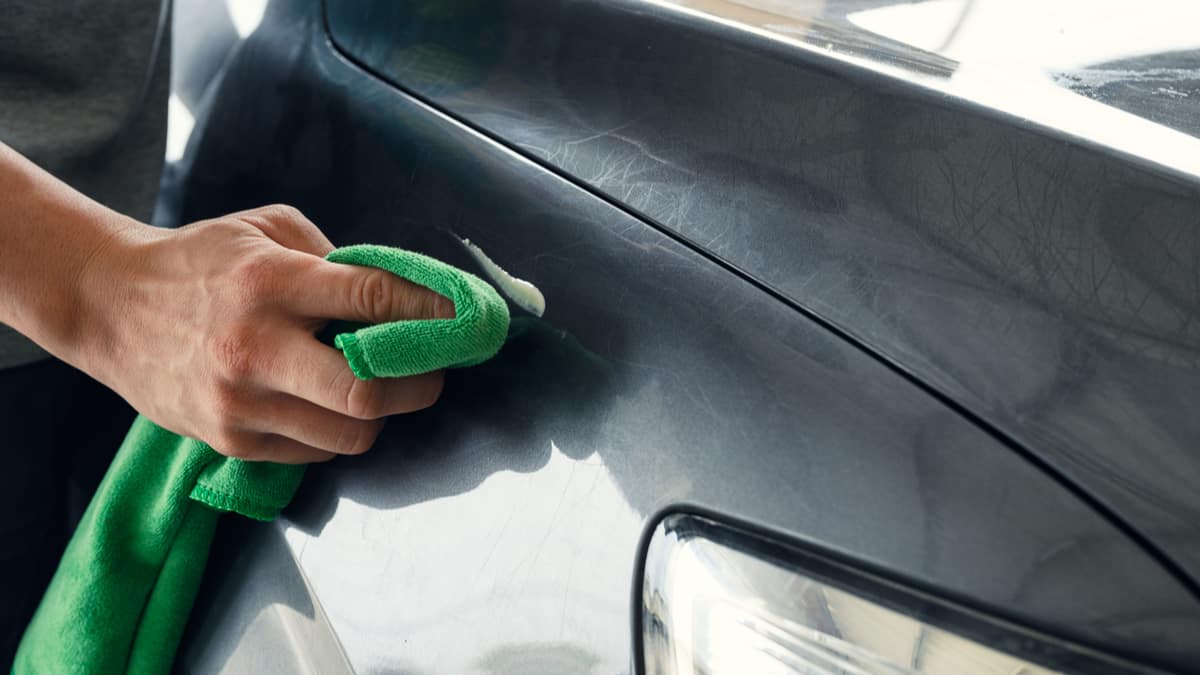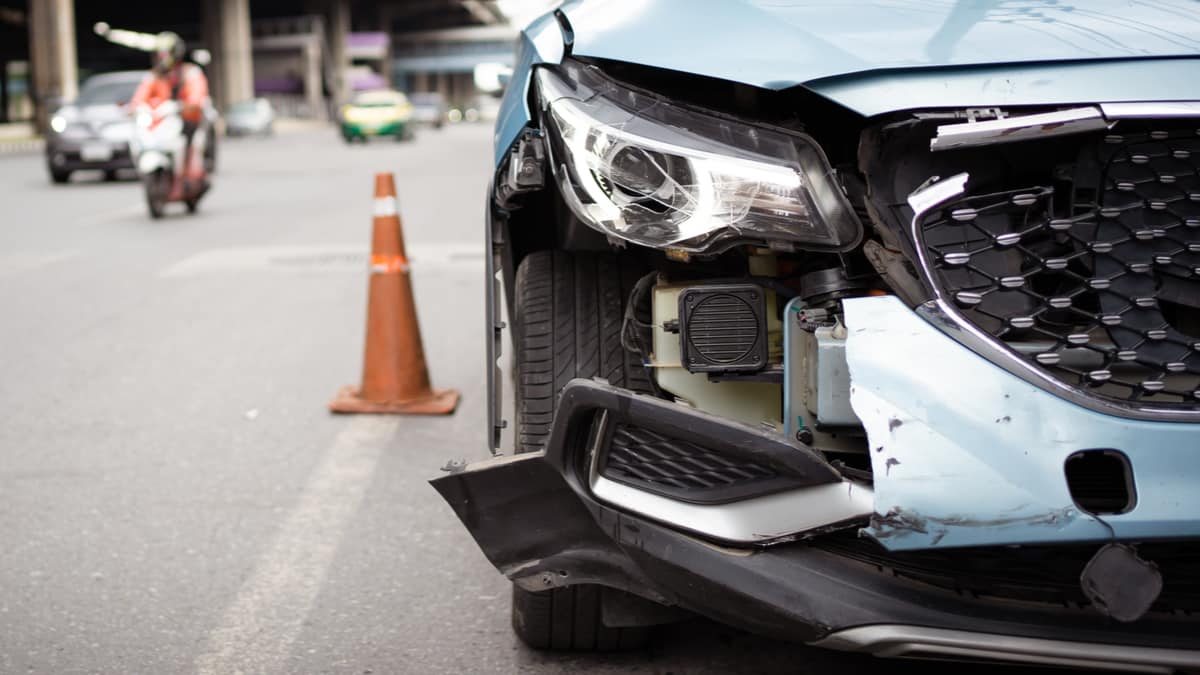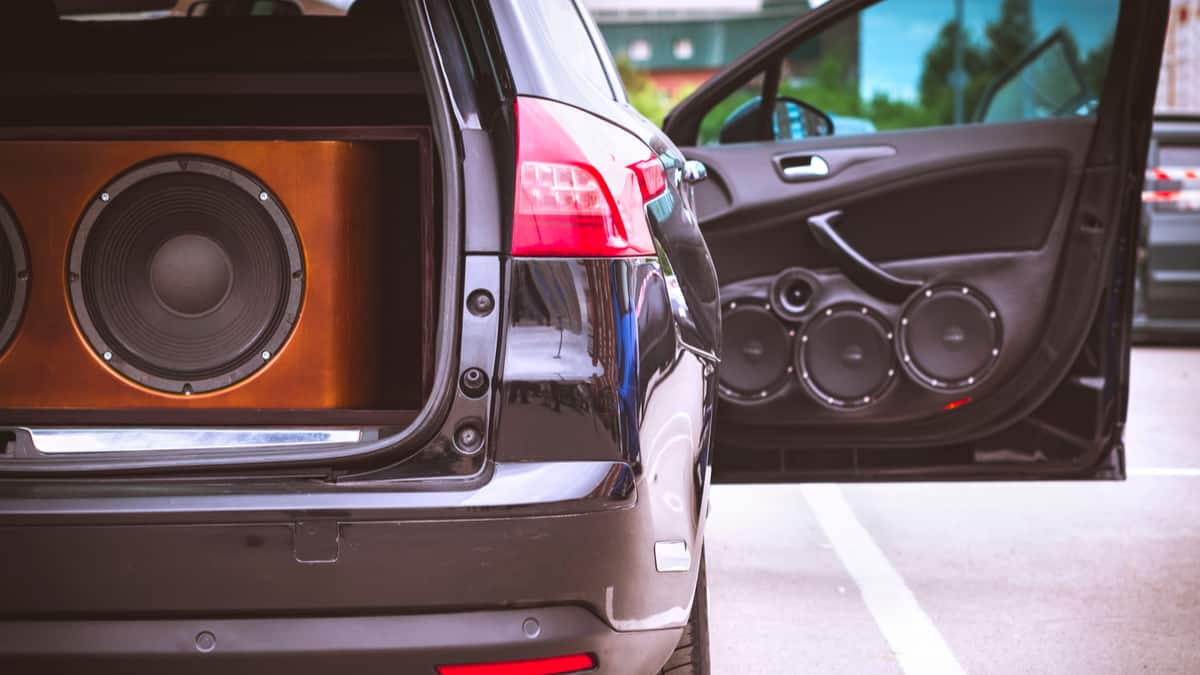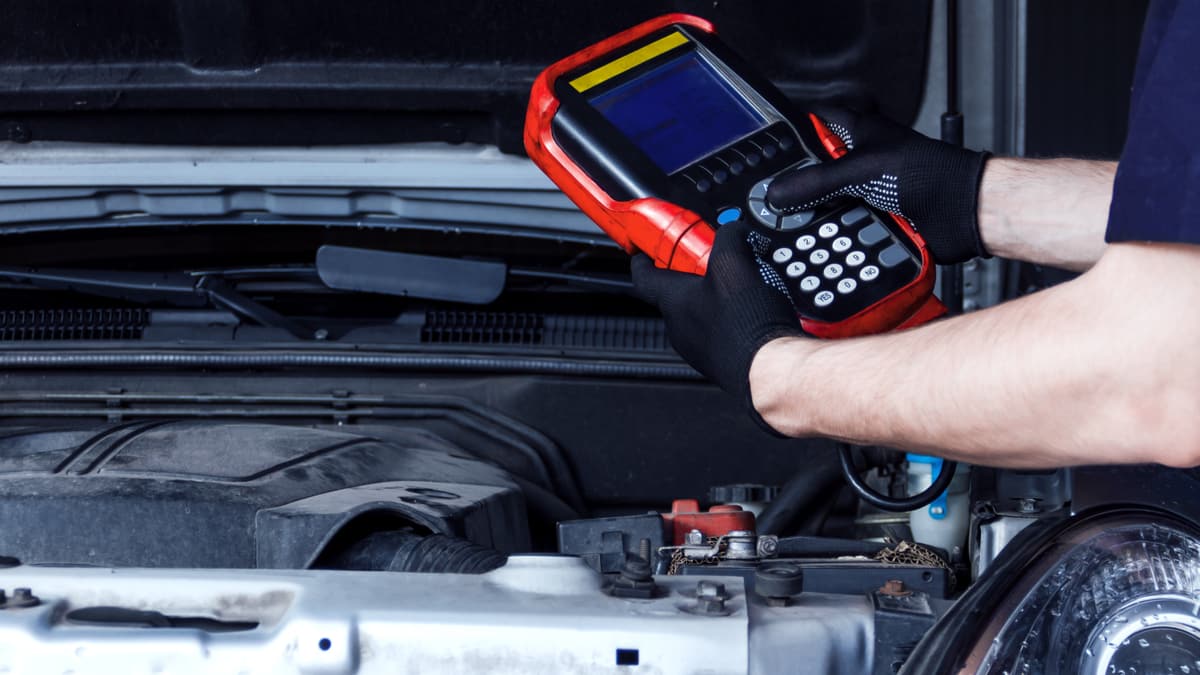Are you tired of looking at scratches on your vehicle? So are we. The good news is that most of the time you don’t need expensive repairs and you can buff those scratches right out.
However, while the right buffer will leave your car looking like new, the wrong one can make things look even worse and sometimes lead to full-blown scratches.
It’s a high-stakes job which is why you need to get the right equipment the first time. We understand, and it’s why we wanted to highlight some of the best car buffers on the market today.
Not only that, but we came up with a comprehensive buyer’s guide to help you pick out the perfect car buffer for your vehicle and help you buff out those problem areas in no time!
Disclaimer – This article may contain affiliate links, this means that at no cost to you, we may receive a small commission for qualifying purchases.
10 Best Car Buffers and Polishers
1. Chemical Guys TORQX Complete Detailing Kit – Best Car Buffer Overall
If you’re looking for a top-notch kit that gives you everything you need to buff your vehicle like a pro then the Chemical Guys TORQX Complete Detailing Kit is what you need.
Not only does it come with a top-notch TORQX buffer, but it has the microfiber rags, conditioning cloths, and cleaning and conditioning compounds you need to buff, clean, and polish your vehicle.
The buffer itself has a variable speed between 1,200 and 4,200 rpm, which lets you get the exact amount of movement you need for the job. Not only that, but it’s a dual-action movement polisher for even higher-quality results.
Not only does this Chemical Guys TORQX Complete Detailing Kit give you everything you need to get started, but it gives you everything you need for professional-quality results. Add in the outstanding price tag and it’s a no-brainer as our top choice.
We do wish that the 5.5″ buffing pad was a little bit bigger, but since most pads are 6″, it’s not like you’re losing a ton of size with this kit.
Pros
- It comes with everything you need
- A great mix of price and performance
- Outstanding quality buffer
- Easy to adjust orbiter speed – 1,200 to 4,200 rpm
- Dual-action movement polisher
Cons
- Slightly smaller buffing pad – 5.5″
2. Black + Decker 6″ Random Orbit Waxer/Polisher – Best Budget
If you don’t want to spend a ton of money but still need a top-notch buffer for your vehicle, then the Black + Decker 6″ Random Orbit Waxer/Polisher is an outstanding choice.
While you’ll need to invest in the buffing pads and compounds before you can use it since you’re getting the orbital buffer for such a great price that’s not a huge deal.
It’s a small and lightweight device that uses a 6″ pad. Moreover, the double handle design makes it easy to control – even in tight spaces. But with all those perks, the most important reason that the Black + Decker 6″ Random Orbit Waxer/Polisher earned this spot comes down to its durability.
Even with this lower price tag it’ll last year after year no matter how much you use it. However, it is a lower-priced option, and that really shines through with the features.
It only has one speed, and at 4,400 rpm, it’s a little fast for finer applications. Moreover, it doesn’t come with any chemicals, microfiber rags, or even buffing discs so you’ll need to make more purchases before you can use it. But at this price point, you’re still getting a great deal, even without all those accessories.
Pros
- Very affordable
- 6″ buffing pad
- Lightweight and easy to use
- Double handle design
Cons
- It doesn’t come with any chemicals
- Only one speed – 4,400 rpm
3. Meguiar’s MT300 Dual Action Variable Speed Polisher – Premium Choice
If you’re looking for a professional-quality car buffer that you can use year after year without any problems, then Meguiar’s MT300 Dual Action Variable Speed Polisher is exactly what you need.
It has a wide operating range with speeds between 3,000 and 7,500 rpm, giving you the ultimate control to get the exact results you need when you’re working. Not only does the Meguiar’s MT300 Dual Action Variable Speed Polisher do a great job as a car buffer, but it also works as a polisher and a waxer, letting you finish the job with just one tool.
Add in the fact that it’s extremely durable and long-lasting, and it’s worth every penny. But there’s no denying that while it’s an outstanding choice that’s worth it, all those pennies still add up for this buffer. It’s a more expensive option, and unless you plan on doing a lot of buffing, you probably don’t need to spend this much to get the best of the best.
Pros
- Wide operating range – 3,000 to 7,500 rpm
- Lightweight and easy to use
- It lets you buff, polish, and wax with one device
- Extremely durable and long-lasting
- Professional quality results
Cons
- More expensive option
4. DeWalt Buffer/Polisher Variable Speed
Picking between Meguiar’s MT300 Dual Action Variable Speed Polisher and the DeWalt Buffer/Polisher Variable Speed was no easy choice. That’s because the DeWalt Buffer/Polisher Variable Speed has a wide operating range that starts as low as 0 rpm and goes all the way up to 3,500 rpm.
Just like the Meguiar’s MT300 this DeWalt Buffer gives you professional quality results. Another huge perk for the DeWalt buffer is that it comes with a 3-year warranty, so you know it will last no matter how much or how little you use it.
It is a more expensive option though, but since you know you’re not going to have to replace it anytime soon we’re alright spending a little more upfront.
It’s an extremely effective tool for both buffing and polishing, but the real reason it couldn’t crack our top three is its lower maximum rpms. While 3,500 rpm is high enough for most jobs, if you do find yourself needing a little more speed, the DeWalt Buffer simply can’t keep up.
Pros
- Wide operating range from 0 to 3,500 rpm
- It comes with a 3-year warranty
- Very effective at polishing and buffing
- Professional quality results
Cons
- More expensive option
- Lower maximum rpm
5. Meguiar’s G3500 Dual Action Power System Tool
This is the second Meguiar’s product to make our list, but it’s extremely different than the other one. This buffer attaches to a standard household drill, meaning it’s not a standalone buffer. But if you already have a household drill, then you can save yourself a ton of money by avoiding an all-in-one unit.
The Meguiar‘s G3500 Dual Action Power System Tool is extremely easy to use and it does an excellent job buffing, polishing, and waxing. However, the battery-powered system does come with a few drawbacks.
First, it has a maximum operating speed of 2,500 rpm, which is slower than most standalone units. Furthermore, it’s extremely tough to control the exact orbiting speed. There’s no controllable dial, it all comes down to the features your drill has to control the speed.
Another issue is that you’re only getting the attachment and one covering pad, you still need to purchase all the additional chemicals to actually buff something.
Still, it’s a great compact tool you can easily take from place to place, and you don’t have to spend a ton to get it. If you already have a household drill, this is an attachment you’ll want to consider.
Pros
- Affordably priced
- Great for buffing, polishing, and waxing
- It fits on most standard drills
- Easy to use
- It provides between 1,200 and 2,500 rpm
Cons
- Lower maximum rpm
- Tough to control the speed
- Not a standalone system
- You still don’t get any chemicals
6. Milwaukee 2738-20 M18
While most of the car buffers on our list use a corded connection, the Milwaukee 2738-20 M18 does something different. It’s a battery-powered buffer that uses a standard 18V lithium-ion battery like you’d find in most household drills.
But while this buffer uses a typical drill battery, it’s not a drill attachment. This gives you the distinct advantage of being able to set the rpm easily. It goes anywhere from 0 to 2,200 rpms, letting you get the exact results you need to get the job done.
This buffer fits larger 7″ buffing pads that lets you work quicker, and it’s both lightweight and portable so you can take it from place to place.
But even with these perks this buffer couldn’t climb any further up our list for three reasons. First, it’s the most expensive buffer on our list. Second, it doesn’t come with the battery you need to operate it. And since the rechargeable lithium-ion battery you need isn’t the lowest cost option out there, this drives the cost up even further.
The final issue is the maximum rpm. While we could justify spending more to get the extra portability, with a maximum rpm of 2,200 it’s one of the slowest options on our list.
Pros
- It fits up to 7″ pads
- Battery-powered
- Lightweight and portable
- Decent operating range – 0 to 2,200 rpm
Cons
- Very expensive option
- It doesn’t include a battery
- Lower maximum rpm
7. SPTA Buffer Polisher Kit
While SPTA Buffer Polisher Kit might not come from one of the most recognizable brands in the industry, that doesn’t mean it’s not worth checking out. In fact, if you’re on a tighter budget and are working from a home garage, the SPTA Buffer Polisher Kit might be the perfect choice.
Not only does this kit come with a polisher, but it also comes with everything else you’ll need to get started. That includes the polishing and buffing compounds, the pads, and even microfiber cloths. Even better, it comes with a one-year warranty on the buffer, so you don’t have to worry about it breaking.
While you can’t pick the exact buffing speed with this kit, it does have six different speed settings you can cycle through for different jobs. Moreover, it takes both 5″ and 6″ pads, giving you even more flexibility
It’s an excellent choice for hobbyists or those looking for a car buffer for their own personal vehicle. However, if you work in a professional automotive setting, this probably isn’t the tool you’re looking for.
While it holds up just fine to occasional use, if you’re using it every day it’s probably not going to last as long as you want. The other issue is that you can’t pick the exact speed, making it a little bit more challenging to achieve professional-level results.
Pros
- Affordably priced
- It comes with everything you need to get started
- It comes with a 1-year warranty
- 6 speeds to pick from
- Great for hobbyists
- You can use 5″ or 6″ pads
Cons
- Not as durable as higher-priced options
- You don’t get to pick the exact speed
8. Ginour Buffer Polisher
The Ginour Buffer Polisher is extremely similar to the SPTA Buffer Polisher Kit in that it comes with more than just the buffer but it doesn’t cost an arm and a leg. Even the buffer itself is extremely similar, with the Ginour Buffer Polisher having six speed settings you can cycle through exactly like the SPTA Buffer.
This kit comes with five different pads for different applications, and it comes with a carrying case to help you store it or take it from place to place. It’s an outstanding choice for beginners, but it’s not really an excellent choice for professionals.
Not only does it not let you pick the exact speed you want, but it’s not durable enough to handle everyday use. You probably won’t have any issues with it if you’re only using it for your own personal vehicle, but if you’re constantly working with it then it won’t last too long.
Even worse it doesn’t come with a warranty so if it does break on you, you’re out of luck. The other issue with the Ginour Buffer compared to the SPTA buffer kit is that this kit still doesn’t come with the polishing compounds you need.
So, while you’re getting either kit for about the same price, you’re going to need to spend more money to actually use the Ginour kit. It’s still a great deal at this price point, but with the SPTA kit on the market, it’s hard to justify going with this one.
Pros
- Affordably priced
- It includes multiple pads
- Six speed settings for different applications
- Great tool for beginners
Cons
- Not as durable as higher-priced options
- You don’t get to pick the exact speed
9. GoPlus Electric Car Polisher
The GoPlus Electric Car Polisher is another affordably priced car buffer that you can get. Even better, it comes with more than just the buffer, giving you an even better bang for your buck.
You get the buffer, two polishers, sandpaper, and the attachable head to put everything on. That means if you’re looking to buff areas of your vehicle, you’ll still need to purchase some chemical compounds and the discs to get the best possible results.
But while this buffer doesn’t come with everything you need, with a 600 to 3,100 rpm range you can buff, polish, and wax all with this one buffer. It’s extremely easy to use and a great choice for beginners, but once again, it’s not something you’ll want to go with if you’re a professional.
Not only is the maximum 3,100 rpm on the slower side of things, but it’s simply not as durable as some of the top brands. Once you add in the cumbersome ten-pound weight it’s simply not the best choice out there.
But if you’re not looking to spend a ton you could do far worse than the GoPlus Electric Car Polisher.
Pros
- Affordably priced
- It comes with buffers, sandpaper, and polishers
- Variable speed – 600 to 3,100 rpm
- Easy to use
Cons
- Not very durable
- 10-pound weight
10. WEN 948 Variable Speed Polisher
The WEN 948 Variable Speed Polisher might be the last option on our list, but that doesn’t mean it’s not a great choice for you. It’s a more affordable buffer, but its real claim to this list rests with its 7″ pad. It’s larger than most other buffers out there, and that lets you get larger jobs done faster.
It uses a variable speed that starts as low as 1,500 and goes all the way up to 3,500 rpm. Even better, it has a digital display to show you the current speed, making it extremely easy to use.
But while those are all great things about the WEN 948 Variable Speed Polisher and a real reason you should consider it, it did fall to the bottom of our list for a reason.
It all starts with the durability. While it has no problem in the hands of a hobbyist that might use it a few times a month, if you’re a professional it’s not going to last as long as you want. Moreover, while it has an adjustable speed, you have to adjust it in increments of 500 rpm.
That means you really only have five-speed settings, even if the digital display makes it feel like you have more.
Pros
- Very affordable
- 7″ pad
- Digital display
- Variable speed – 1,500 to 3,500 rpm
Cons
- Rpm changes are in increments of 500
- Not great for heavy use
Car Buffer Buyer’s Guide
With so many great options out there, it can be a little overwhelming trying to narrow it down to just one. We understand, and that’s why we came up with this buyer’s guide to walk you through everything you need to know.
Not only will we walk you through all the important specifications for your new car buffer, but we’ll also walk you through everything you need to know to fix the problem areas on your vehicle in no time once you get your new car buffer!
How Many RPMs Do You Need?
While you might think that more RPMs are always better when you’re buffing your vehicle, that’s not always the case. That’s because the higher the RPMs the more friction you create which creates heat.
If things get too hot, you’ll start to see swirl marks on your vehicle, and this can be a pain to fix. Try to stick with about 2,000 to 2,500 rpms when buffing and slow it down even further when you’re finishing with wax.
However, if you do have larger problem areas having a buffer that can work at higher speeds gives you even more capabilities when you’re trying to address other problems with your vehicle.
What Size Buffing Pad Do You Need?
While we’d love to tell you that one size buffing pad will do everything possible for your vehicle, that’s just not the case. That’s because it all comes down to the area you’re trying to buff on your car.
For larger body panels you’ll likely want a 6.5″ or 7″ buffing pad since they cover a larger area and allow you to get the work done faster. However, if you’re looking at a smaller body panel in a tight space, those larger pads might be impossible to work.
In those situations, you might want something far smaller, like a 4″ or even 3″ pad. Keep in mind that while you can often downsize the pad on your buffing wheel, that won’t always give the extra versatility you need because of the size of the backing plate.
You can’t go the other way with it either because if the backing plate isn’t large enough you won’t be able to apply the pressure you need no matter the size of the buffing pad.
Battery Powered vs Corded Car Buffers
One of the most important decisions you’ll need to make when you’re picking out a vehicle buffer is the power source. Most of the buffers on our list use a corded system, and that’s because these systems offer a few advantages.
First, they typically offer more power than you can get from a corded buffer. This enables higher rotation speeds which can be a significant advantage depending on the job you’re trying to complete.
Another advantage of a corded system is that you don’t have to worry about running out of power no matter how much you use it. But while these are clear advantages for a corded car buffer, there are some situations where a battery-powered car buffer makes more sense.
When this is clearly the case is when you don’t have access to a power outlet. It doesn’t matter how awesome your car buffer is if you can’t plug it in. With a battery-powered car buffer this isn’t a problem.
You simply charge up the battery and take it wherever you need it. However, since you’re relying on a battery, you do have to worry about it dying on you when you’re in the middle of a job.
When this happens you need to stop what you’re doing and wait around for a while so it can recharge, or you need to spend more money on backup batteries.
The other issue isn’t that an 18-volt or even a 20-volt battery simply can’t carry as much power as a traditional outlet. Because of this the buffers typically top out at slower speeds. While the companies could program them to go faster, this would drain the battery too fast and you wouldn’t be able to finish any job without swapping out the batteries.
Because of all this, we recommend a corded car buffer for most situations, unless you won’t have access to a power outlet. And if you’re going to go with a battery-powered car buffer, get an extra battery or two on order so you have a backup ready to go if you need it.
Picking the Right Buffing Chemical
While getting the right car buffer is a huge part of the process, it’s just as important that you go with a quality chemical. While a few of the options on our list come with a buffing compound and polisher that you can use, others leave it up to you.
And getting the right buffing compound is just as important as getting the right car buffer. The right compound will clear up the scuffs while leaving the paint intact, while the wrong ones will tear up your vehicle and make everything look awful.
Because of this you really don’t want to skimp out on the buffing compounds. You also don’t want to just get the buffing compound. Every step in the process is extremely important, and you’ll need three chemicals to do the job right.
If you’re shopping for a buffing chemical, you’ll need both a polish, a buffing compound, and a wax to do the job right. There are a few great chemicals out there, but we recommend going with either this Chemical Guy’s Kit or purchasing the buffing compound, polish, and wax from Meguiar’s. You can also purchase this cleaning compound for the initial wash.
While Meguiar’s doesn’t typically offer those things together in a kit, if you just follow the three links above, it’ll give you everything you need to buff your vehicle.
Buffing Your Vehicle
Now that you know a little more about everything you’ll need, it’s time to give you a quick lesson on how to buff out your vehicle so you know everything you need to do when it comes in.
1. Wash Your Car
Any dirt or grime that you leave on your vehicle can easily scratch things up when you start buffing, so always start by washing your vehicle. Use a high-quality cleaning compound and get everything off before you even think about moving to the buffer.
2. Cover Things You Don’t Want to Buff
While some professionals might skip this step if they’re extremely confident in their craft, we highly recommend covering things up you don’t want to buff if you’re working near them.
Buffing creates a lot of heat, and if you’re not careful when you’re working this heat can break down other components on your vehicle.
3. Buff It Out!
Now you’re ready to buff! Use your new buffer and the recommended buffing compound to work out the problem spots on your vehicle. You can also work your entire vehicle if you want to give it a great final look.
4. Time to Polish
Once you finish buffing it’s time to polish. This will give your vehicle a top-notch look and fill in any of the clearcoat that came off during the buffing process and during the initial scuffs.
If you’re buffing you need to polish, otherwise you’re simply exposing your vehicle to more potential damage.
5. Wax
After you polish it’s time to protect all the hard work you just put into your vehicle. That’s exactly what you’re doing when you’re waxing the vehicle. You’re putting a protective layer between the polish and the elements, and this helps keep your work looking pristine.
Don’t go through all that work just to skip this last step and have your vehicle right back where you started in no time.
6. Add the Final Touches
You just went through all that hard work to make your vehicle look great, go ahead and add some final touches to the rest of the vehicle. Wash the windows, headlights, shine the tires, and clean out the interior.
It’s a lot of work, but when you’re putting this much work into your vehicle, you might as well do it right the first time by doing everything. When you finish, your vehicle will look like it just came from the factory!
Now that you know a little more about buffing your vehicle, it’s time to get your new buffer on order. While it might seem like something you can put off, if you don’t buff the problem areas out and re-wax them, those areas can turn into full-blown scratches that you can’t fix.
So, get a car buffer and everything you need on order today, that way you can get to fixing your vehicle as soon as possible!
Categories: Cleaning & Detailing, Reviews

